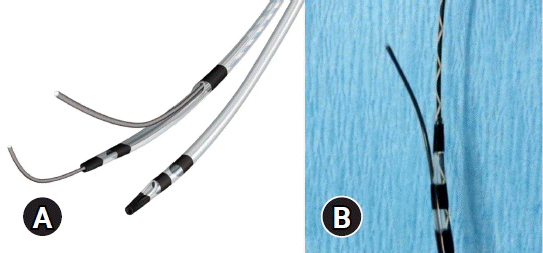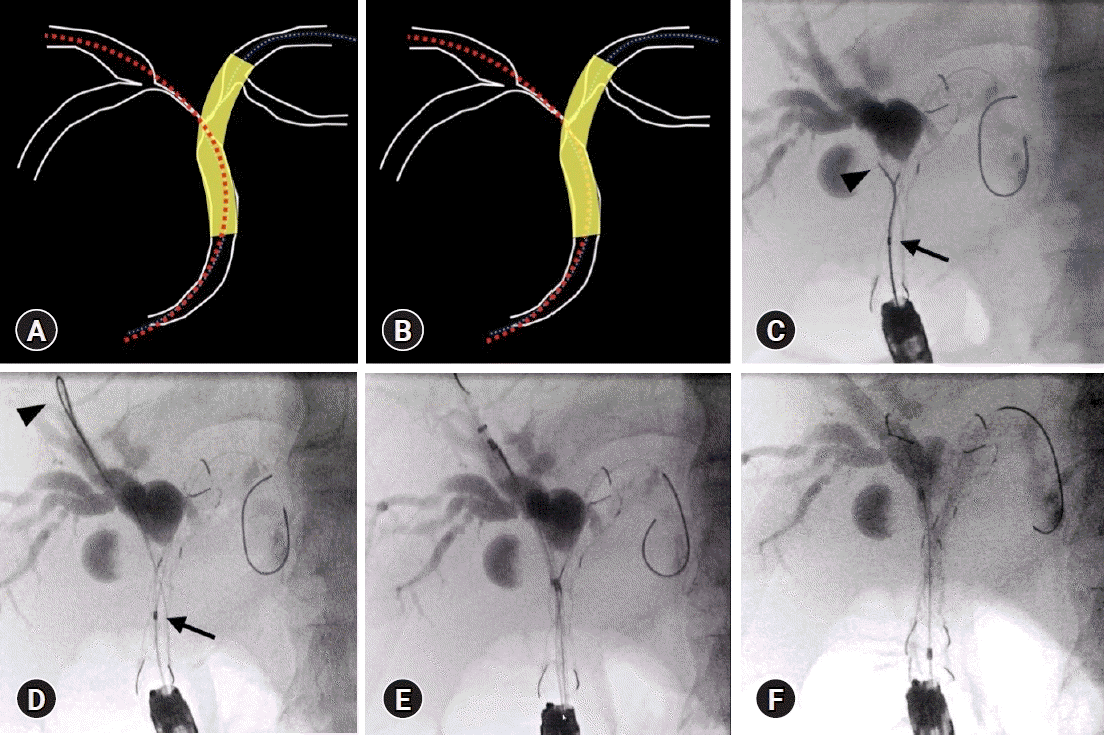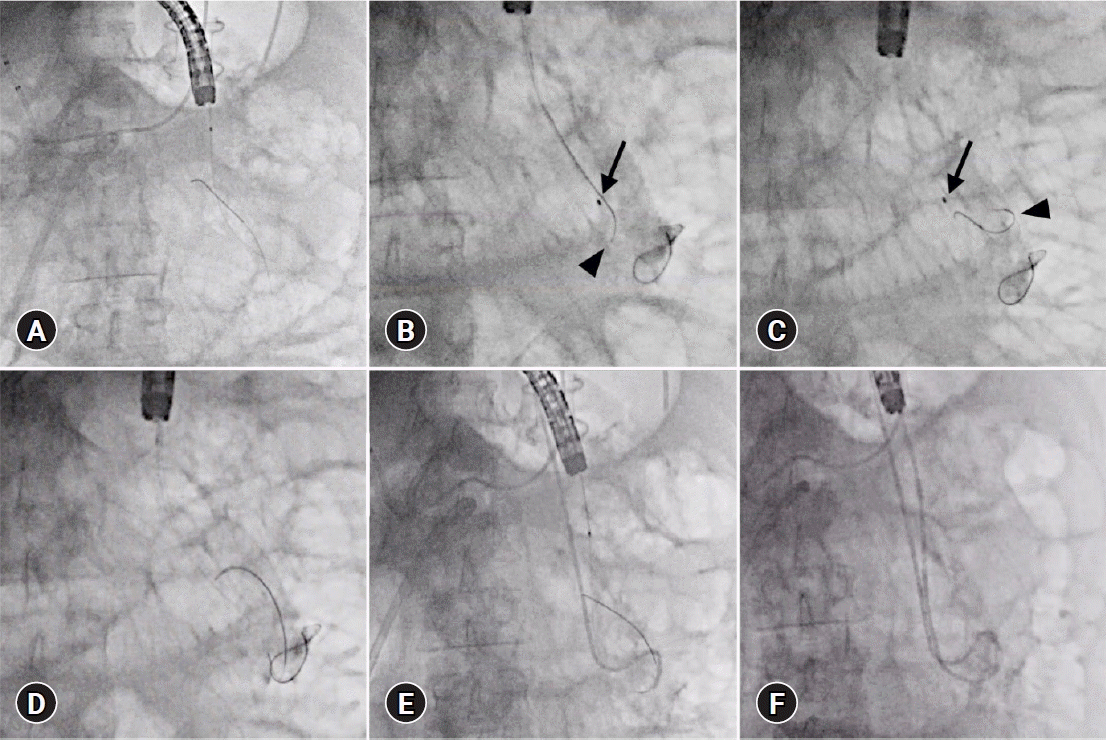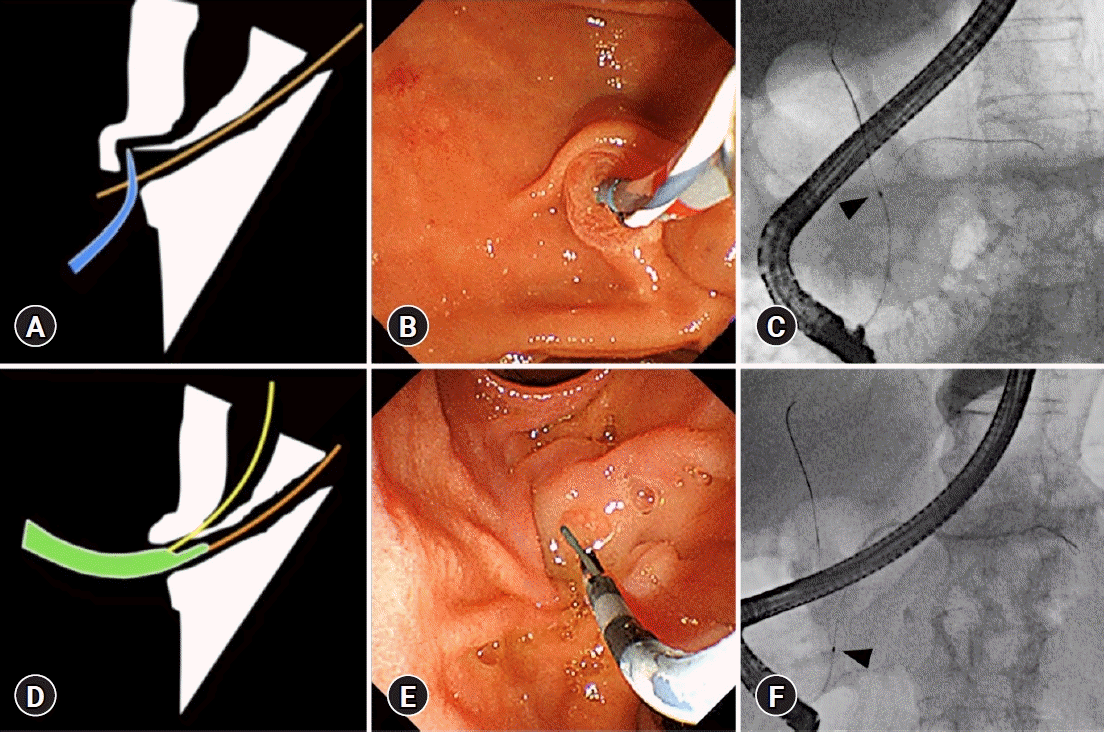INTRODUCTION
 | Fig. 1.(A) Schema of the uneven double-lumen cannula (UDLC). The UDLC (PIOLAX, Tokyo, Japan) is a double-lumen catheter with lumens measuring 0.025 (distal) and 0.035 (proximal) inches in diameter. The orifice of each lumen is uneven, creating a channel at the tip. (B) A guidewire can be manipulated from the proximal lumen of the UDLC. |
USEFULNESS OF THE DOUBLE-GUIDEWIRE METHOD IN THE SELECTIVE INSERTION OF GUIDEWIRES AND DEVICES
Usefulness in ERCP-related transpapillary procedures
 | Fig. 2.Double-guidewire method with uneven double-lumen cannula for the placement of a self-expandable metal stent (SMS) using the stent-in-stent (SIS) method. (A) Guidewire situation where the SIS method was unsuccessful. The guidewire for the second stent insertion was not passed through the mesh of the first stent. (B) Guidewire situation where SIS was successful. The guidewire for the second stent insertion is passed through the mesh of the first stent. (C) The uneven double-lumen cannula was inserted into the stent using the guidewire used for the first stent placement (arrow), and the guidewire tip (arrowhead) from the proximal lumen passed through the stent mesh. (D) The UDLC was inserted into the stent using the same guidewire used for the first stent placement (arrow), and the guidewire tip (arrowhead) was guided from the proximal lumen into the drainage area. (E) The second stent delivery was through the mesh of the first stent. (F) Successful SMS placement using the SIS method. |
Usefulness of the DGT in EUS-guided cyst drainage
 | Fig. 3.Double-guidewire method using the uneven double-lumen cannula for endoscopic ultrasonography cyst drainage. (A) One guidewire was inserted into the lumen of the walled-off necrosis (WON). (B) The uneven double-lumen cannula (arrow) was inserted into the WON, and the guidewire (arrowhead) was manipulated from the proximal lumen. (C) The UDLC (arrow) was inserted into the WON, and the guidewire (arrowhead) was inserted deep into the WON. (D) Double-guidewire situation. (E) First, a plastic stent was inserted. (F) Thereafter, a nasocystic drainage tube was inserted. |
Usefulness of the DGT in EUS-guided biliary drainage
USEFULNESS OF THE DOUBLE-GUIDEWIRE METHOD FOR BILIARY CANNULATION
The PGW method
 | Fig. 4.Double-guidewire method using the uneven double-lumen cannula (UDLC) for biliary cannulation. (A) Schema of the pancreatic duct guidewire method. (B) The papilla was fixed with a guidewire and a cannula was used for biliary cannulation. (C) A cannula (arrowhead) was inserted into the bile duct. (D) Schema of the uneven method. (E) The papilla was fixed with the UDLC itself, and biliary cannulation was attempted with a guidewire from the proximal lumen. (F) The papilla was fixed by the UDLC (arrowhead), and a guidewire from the proximal lumen was inserted into the bile duct. |
 | Fig. 5.Transpancreatic sphincterotomy. (A, B) The papilla was fixed with a pancreatic guidewire (arrowhead) and a sphincterotome was inserted using the pancreatic guidewire. (C, D) Sphincterotomy was performed with the pancreatic duct guidewire in place (arrowhead). (E, F) Successful wire-guided biliary cannulation was achieved (arrow) using the sphincterotome with the pancreatic duct guidewire in place (arrowhead). |
Table 1.
| Study | Design | Patient | C | N (PGW/C) |
Technical success rate |
Incidence of PEP |
|||||
|---|---|---|---|---|---|---|---|---|---|---|---|
| Definition of selective biliary cannulation | PGW (%) | C (%) | p-value | PGW (%) | C (%) | p-value | |||||
| Maeda et al. (2003)33 | Single-center | Failed within 10 min | Standard | 27/26 | Overall | 93 | 58 | <0.05 | 0 | 0 | NS |
| RCT | |||||||||||
| Herreros de Tejada et al. (2009)30 | Multicenter | Failed within 5 min | Standard | 97/91 | Overall | 47 | 56 | 0.128 | 17 | 8 | 0.0791 |
| RCT | |||||||||||
| Cote et al. (2012)28 | Multicenter | Failed within 6 min, or guidewire was introduced into the PD unintentionally 3 times | PS | 42/54 | Within 6 min | 38.1 | 51.9 | 0.18 | NR | NR | NR |
| RCT | Overall | 66.7 | 90.7 | NA | NR | NR | NR | ||||
| Angsuwatcharakon et al. (2012)27 | Single-center | Failed within 10 min | Pre-cut | 23/21 | Overall | 73.9 | 80.9 | 0.724 | 21.7 | 14.3 | 0.701 |
| RCT | |||||||||||
| Yoo et al. (2013)36 | Single-center | Failed within 10 min or 10 attempts | TPS | 34/37 | Overall | 91.2 | 91.9 | 0.732 | 38.2 | 10.8 | <0.011 |
| RCT | |||||||||||
| Sasahira et al. (2015)34 | Multicenter | Guidewire was introduced into the PD unintentionally | Standard | 137/137 | Within 10 min or 10 attempts | 75 | 70 | 0.42 | 20 | 17 | 0.53 |
| RCT | Overall | 98 | 97 | 1.00 | |||||||
| Sugiyama et al. (2018)35 | Single-center | Failed within 15 min using NK, or guidewire was introduced into the PD 3 times | TPS | 34/34 | Overall | 58.8 | 94.1 | 0.001 | 2.9 | 2.9 | NS |
| RCT | |||||||||||
| Eminler et al. (2019)29 | Single-center | Failed within 5 min, or guidewire was introduced into the PD 5 times | PS | 50/50 | Overall | 90 | 54 | <0.001 | 2 | 2 | NS |
| RCT | |||||||||||
| Kylanpaa et al. (2021)31 | Multicenter | Failed within 5 min or 5 attempts, or guidewire was introduced into the PD >1 time | TPS | 99/104 | Overall | 69.7 | 84.6 | 0.01 | 16.2 | 13.5 | 0.69 |
| RCT | |||||||||||
| Laquiere et al. (2022)32 | Multicenter | Guidewire was introduced into the PD unintentionally | Standard | 68/74 | Within 10 min | 84 | 50 | <0.001 | 1 | 5 | NS |
| RCT | |||||||||||
C, comparator; N, number of patients per study group; PGW, pancreatic guidewire-assisted method; PEP, post-endoscopic retrograde cholangiopancreatography pancreatitis; RCT, randomized controlled trial; NS, not significant; PD, pancreatic duct; PS, pancreatic stent-assisted method; NR, not reported; TPS, transpancreatic sphincterotomy; NK, needle-knife technique.




 PDF
PDF Citation
Citation Print
Print



 XML Download
XML Download